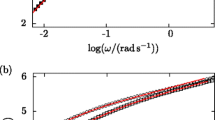Abstract
We evaluate the flow activation volume in polymer melts of isotactic polypropylene and atactic polystyrene with step-shear experiments at different melt temperatures. The melt is initially sheared with constant shear rate until the attainment of a melt state with nearly constant viscosity. Perturbations to this experiment, involving shear steps in short-time intervals with decreasing rates, are induced next. Measurements of the shear stress value at each shear rate step allow the evaluation of an experimental (apparent) flow activation volume. The true flow activation volume is evaluated by extrapolating the experimental data to infinite shear stress values. The value obtained is larger than the physical volume of the chain and agrees with the volume of a tube confining chains with a molecular weight between M n and M w. Besides supporting the validity of tube model, experiments based on this protocol may be used on model polymer samples, in composites with nanoparticles and in polymer blends to access the validity of mechanisms considered by flow models.

Symbols in the figure represent the apparent values of flow activation volume of atactic polystyrene evaluated from the step shear experiments. Fitting of the data with an equation derived from the rate theory of plastic deformation, allows the true flow activation volume to be evaluated by extrapolating the data to an infinite shear stress value. The true flow activation volume compares to the volume a tube confining the polymer chains.






Similar content being viewed by others
References
Moe NE, Qiu X, Ediger MD (2000) Macromolecules 33:2145–2152
Qiu X, Ediger MD (2000) Macromolecules 33:490–498
Doi M, Edwards SF (1986) The theory of polymer dynamics. Oxford University Press, New York
de Gennes PG (1971) J Chem Phys 55:572–579
Schleger P, Farago B, Lartigue C, Kollmar A, Richter D (1998) Phys Rev Lett 81:124–127
Vaca Chávez F, Saalwächter K (2011) Macromolecules 44:1549–1559
Likhtman AE (2009) J Non-Newtonian Fluid Mech 157:158–161
Gao J, Weiner JH (1989) Macromolecules 22:979–984
Krausz AS, Eyring H (1975) Deformation kinetics. Wiley, New York
Caillard D, Martin JL (2003) Thermally activated mechanisms in crystal plasticity, Pergamon Materials Series, vol 8. Elsevier, Lausanne
McGrum NG, Buckley CP, Bucknall CB (1997) Principles of polymer engineering, 2nd edn. Oxford University Press, New York
Kazmierczak T, Galeski A, Argon AS (2005) Polymer 46:8926–8936
Fetters LJ et al (1994) Macromolecules 27:4639–4647
Lin YH (1987) Macromolecules 20:3080–3083
Alefeld GZ (1962) Naturforsh A 17:899
Martins JA, Zhang W, Brito AM (2006) Macromolecules 39:7626–7634
Rubinstein M, Colby RH (2003) Polymer physics. Oxford University Press, Oxford
Acknowledgments
We thank Andrzej Galeski for pointing us ref. [10]. We acknowledge the Portuguese Foundation of Science and Technology for funding the project FCOMP-01-0124-FEDER-007151 (PTDC/CTM/68614/2006). This work was supported by the European Community fund FEDER and project 3599/PPCDT.
Author information
Authors and Affiliations
Corresponding author
Rights and permissions
About this article
Cite this article
Martins, J.A., Cruz, V.S., Krakowiak, J. et al. What is the flow activation volume of entangled polymer melts?. Colloid Polym Sci 290, 23–29 (2012). https://doi.org/10.1007/s00396-011-2519-4
Received:
Revised:
Accepted:
Published:
Issue Date:
DOI: https://doi.org/10.1007/s00396-011-2519-4




